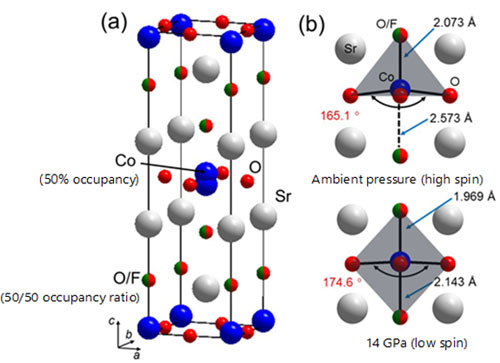Observation of Spin Crossover Phenomena Concurrent With Formation of New Bonds in a Solid Material
2016.11.15
(2017.02.10 Update)
National Institute for Materials Science (NIMS)
Japan Synchrotron Radiation Research Institute (JASRI)
High Energy Accelerator Research Organization (KEK)
A NIMS-led joint research group observed spin crossover phenomena —change in the spin state of cobalt from high to low—in layered cobalt oxyfluoride under pressure. This material had been difficult to synthesize, but the group successfully designed it using a high-pressure synthesis method.
Abstract
- A joint research group led by Yoshihiro Tsujimoto, senior researcher, RCFM, NIMS, Naoki Ishimatsu, assistant professor, Graduate School of Science, Hiroshima University, Masaichiro Mizumaki, associate senior scientist, JASRI, Naomi Kawamura, associate senior scientist, JASRI, and Takateru Kawakami, associate professor, Dept. of Physics, Nihon University, observed spin crossover phenomena—change in the spin state of cobalt from high to low—in layered cobalt oxyfluoride under pressure. This material had been difficult to synthesize, but the group successfully designed and fabricated it using a high-pressure synthesis method. Moreover, despite the fact that this solid material is held together by strong bonding forces, the group found that the spin crossover occurred concurrently with the formation of new bonds between cobalt and fluorine ions through a mechanism heretofore unknown. Given that spin crossover phenomena have rarely been observed in solid materials that do not contain organic molecules, these findings may provide guidance for the design of spin crossover in stable and durable solid materials, and the studied material may be used in the development of pressure sensors and memory devices.
- Spin crossover (or spin transition) is a phenomenon in which the spin state of metal ions shifts between high and low states, and is triggered by external stimuli such as heat, light and pressure. In recent years, active research efforts have been made in this subject as it is of great interest to apply this unique phenomenon to the development of non-volatile memory media in which high and low spin states are considered to be 1 bit (minimum data unit). To induce spin crossover, it is necessary to reduce the difference in energy level between high-spin and low-spin states. For that reason, it is critical to select appropriate ligands that directly influence the electronic states of metal ions. The majority of materials that were previously reported to undergo spin crossover are organometallic complexes that provide many options of ligands, and it is easy to control differences in energy levels between different spin states in these complexes. On the other hand, because solid oxide materials generally do not bind with other types of anions, design of a coordination environment is restricted and therefore, it had been thought to be difficult to induce spin crossover in these materials.
- The research group previously succeeded in the synthesis of layered oxyfluoride (Sr2CoO3F) using a high pressure, high temperature method, which is effective in synthesizing mixed anion compounds. Then the group found that CoO5 has a square pyramidal coordination geometry with a cobalt ion being surrounded by five oxygen ions. In this study, we investigated how the crystal structure and electronic states of Sr2CoO3F respond to pressure. First, we examined the pressure evolution of the crystal structure by synchrotron X-ray diffraction method at the BL-18C station of Photon Factory in KEK. The distance between Co and F atoms, which was quite long under ambient pressure, was gradually shortened as enormous pressure was applied to the material. This outcome indicated the formation of strong covalent bonds, and we confirmed transformation of a square pyramid of CoO5 into an octahedron of CoO5F for the first time in solid materials. In addition, we took measurements of the material using soft X-ray emission spectroscopy at the BL39XU station in SPring-8, and observed spin states change of Co ions under increasing pressure. As a result, we discovered that the spin states gradually changed from high to low as covalent bonds were formed between Co and F atoms.
- In this study, we observed for the first time spin crossover phenomena in mixed anion compounds. Moreover, these results indicate that even within robust oxide materials, new bonds can be formed through appropriate ligand design without changing the composition or basic structure of the materials. In future studies, we plan to investigate whether pressure can induce other desirable electromagnetic properties such as superconductivity and ferromagnetism, thereby assessing the potential of the material for use in the development of functional devices.
- This study was published in Scientific Reports, a British online journal issued by Nature Publishing Group, on November 2, 2016 (local time).

Figure. (a) Crystal structure of Sr2CoO3F under ambient pressure. Oxygen and fluorine atoms are randomly distributed among apical sites, and cobalt atoms undergo site splitting along the c-axis in relation to the O/F distribution. (b) Coordination environment around Co under ambient and high pressures. For simplicity, a Co atom that underwent site splitting is not shown.
Related files
- Research Center for Functional Materials
Contacts
(Regarding this research)
-
Yoshihiro Tsujimoto
Senior researcher, Quantum Solid State Materials Group, Research Center for Functional Materials (RCFM), NIMS
Tel: +81-29-859-2553
E-Mail: TSUJIMOTO.Yoshihiro=nims.go.jp
(Please change "=" to "@")
(for general inquiries)
-
Public Relations Office
National Institute for Materials Science
1-2-1 Sengen, Tsukuba, Ibaraki, 305-0047, JAPAN
Tel: +81-29-859-2026, Fax: +81-29-859-2017
E-Mail: pressrelease=ml.nims.go.jp
(Please change "=" to "@") -
Public Relations Office
High Energy Accelerator Research Organization
1-1 Oho, Tsukuba, Ibaraki, 305-0801, JAPAN
Tel: +81-29-879-6047
Fax: +81-29-879-6049
E-Mail: press=kek.jp
(Please change "=" to "@")
(Regarding Spring-8/SACLA)
-
Communications and Outreach Section, User Administration Division, Japan Synchrotron Radiation Research Institute
Tel: +81-791-58-2785
Fax: +81-791-58-2786
E-Mail: kouhou=spring8.or.jp
(Please change "=" to "@")
